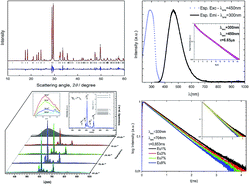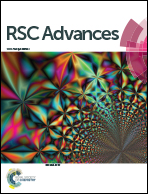Energy transfer in single phase Eu3+-doped Y2WO6 phosphors
Abstract
Inorganic phosphors based on monoclinic Y2WO6 doped with Eu3+ ions were prepared via conventional solid-state reactions at high temperature. A total of five samples were obtained with different Eu3+ concentrations (0–9%). The purity of the as-prepared phases was checked by powder X-ray diffraction (PXRD). Through the Rietveld refinement, at low concentrations Eu3+ ions are found to occupy preferentially the Y2 (2f) sites in the host compound. However, for higher dopant concentrations, the occupancy of the (2e) and (4g) sites becomes relevant. The excitation, emission, and time-resolved emission spectra were examined in detail. Efficient energy transfer from the (WO6)6− groups to the Eu3+ activators was observed. The decay curves for the Eu3+ 5D0 → 7F4 transition show a non-exponential behavior that is enhanced with increasing Eu3+ concentration. The experimental decay curves were fitted to the Inokuti–Hirayama model to gain some insight into the mechanism of the interaction between the Eu3+ ions in these phosphors.



 Please wait while we load your content...
Please wait while we load your content...